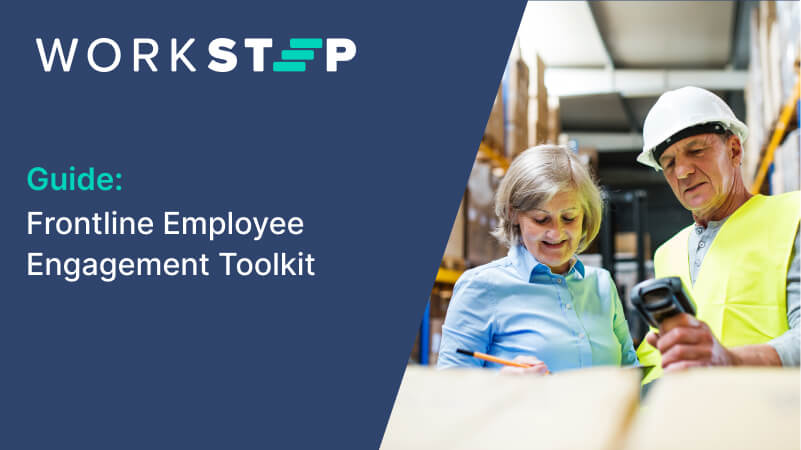Employee engagement refers to the level of commitment, passion, and motivation that employees have towards their work and their employer. Time and time again, it has been shown that engaged workers are more productive, innovative, and loyal to the company than non-engaged workers.
Engaging frontline employees can be particularly challenging as these employees often work in high-pressure environments which can lead to burnout and disengagement. They may also have limited access to communication channels and may not have the same level of flexibility or autonomy as other employees, which can makes it harder to find meaning and connection in their work. Finally, many frontline jobs are physically demanding, and the risk of injury or illness can also cause employee dissatisfaction.
To address these challenges, organizations must be intentional in their approach to engaging frontline employees. There are ten key drivers of frontline employee engagement that organizations should focus on to create a positive and fulfilling work environment. In this blog, we will dive deeper into each of these drivers and explore strategies to improve employee engagement.
1. Clear and communicated expectations
Clear expectations are crucial to building and maintaining employee trust in their leadership teams. When employees understand exactly what is expected of them, they are more likely to feel confident in their roles and more motivated to perform well. Without clear expectations, employees may feel unsure about what they should be doing, which can lead to confusion, frustration, and lapses in productivity.
To set clear expectations, managers should work to define specific, measurable goals and communicate them clearly to employees often. It can be helpful to break down large goals into smaller, more manageable tasks, and to provide employees with regular feedback and support to ensure they are on track. Making frequent touch-points a habit provides more opportunities for managers to identify and celebrate their team’s proficiencies while allowing them to more quickly address negative behaviors. It is important to understand when and how to communicate with employees about things like falling behind on their workload and these moments should be identified before they reach a critical point and should be addressed as a learning experience rather than a reason to reprimand.
Additionally, it is important to align expectations with the employee’s strengths and interests, as this can help to increase motivation and job satisfaction. Communication is key to ensuring that expectations are understood. Managers should take the time to explain goals and tasks in detail, and encourage employees to ask questions and provide feedback. Visual aids, such as flow charts or diagrams, can also be helpful in conveying complex information in a clear and concise manner. By prioritizing clear and effective communication, managers can ensure that employees feel informed, supported, and empowered to do their best work.
2. Recognition and feedback
Employees who receive recognition and feedback are more likely to feel valued, motivated, and will be more likely to engage with leadership in the future because they have developed a sense of belonging. Recognition can be formal or informal and may include rewards, public praise, or opportunities for professional development. Feedback should be specific, timely, and actionable to help employees understand the specific areas they need to work on and the avenues to improve.
Recognition and feedback are critical components of a successful employee engagement strategy. Employees want to know that their contributions are appreciated, after all. Regular feedback sessions allow employees to receive constructive criticism, and they offer an opportunity to provide recognition for a job well done. Providing effective feedback requires managers to use specific examples, focus on behaviors rather than personalities, and provide actionable advice. On the other hand, recognition programs should be designed to align with the organization’s values, goals, and culture. They should also be transparent, inclusive, and consistent.
Strategies for providing effective recognition and feedback include implementing a peer recognition program, conducting regular one-on-one meetings, employee surveys, using online recognition tools, and setting up public recognition displays. A successful recognition and feedback program can foster a positive work environment, increase employee satisfaction, and improve overall performance.
3. Work-life balance
Work-life balance refers to the relationship between an employee’s professional and personal life, allowing them to maintain their health, well-being, and relationships outside of work. Employees who have a healthy work-life balance are more productive and motivated. To promote this, managers can offer flexible work arrangements, such as remote work or flexible hours, and encourage employees to use their paid time off. Additionally, managers can help employees prioritize their work and set boundaries to prevent burnout.
While things like mandatory overtime are the norm, and sometimes necessary, it is vital for site-leaders to understand the toll those situations take on their employees and work to offset that stress in other ways. Promoting work-life balance is crucial to employee engagement, as it can prevent burnout and increase productivity. Employers can offer flexible work arrangements, such as telecommuting or compressed workweeks, providing paid time off and sick leave, and encouraging employees to take regular breaks throughout the workday.
The benefits of promoting work-life balance are numerous, including increased job satisfaction, improved mental health, and decreased absenteeism. Employees who feel supported in maintaining a healthy lifestyle are more likely to be engaged and motivated in their work. Employers can also benefit from promoting work-life balance, as it can lead to higher retention rates and lower recruitment costs.
Overall, promoting work-life balance is a win-win situation for both employees and employers. By recognizing and implementing strategies to support this driver, organizations can create a positive work environment that fosters engagement and well-being.
4. Career development and growth
Career development and growth opportunities are essential drivers of employee engagement. By providing employees with a clear path for advancement and professional development, organizations can motivate and retain their top talent, promote from within, and build brand advocates. Employees want to know that their hard work and dedication will be recognized and rewarded with opportunities for career advancement. When employees feel that they have a clear path for advancement, they are more likely to be engaged in their work, committed to the organization’s mission, and willing to go the extra mile.
To promote career development and growth, organizations should create a culture of learning and development. This can be achieved through regular training sessions, mentoring programs, leadership development programs, and other professional development opportunities. Organizations should also provide employees with clear goals and objectives, as well as regular feedback on their performance. Managers should also have conversations with employees about their career aspirations and provide feedback to help them achieve their goals. This will help employees understand what they need to do to advance in their careers and help them stay engaged in their work.
Promoting career development and growth can lead to a variety of benefits for both employees and the organization as a whole. Employees who feel that they have opportunities for growth and advancement are more likely to be engaged in their work, which can lead to increased productivity, higher job satisfaction, and reduced turnover. From an organizational perspective, promoting career development and growth can help attract and retain top talent, foster a culture of innovation, and improve overall performance.
5. Empowerment and autonomy
Empowerment and autonomy are critical components of employee engagement as they allow employees to take ownership of their work and feel a sense of control over their responsibilities. This promotes trust and builds confidence, leading to higher job satisfaction and engagement. When employees feel that their ideas and input are valued and that they have the freedom to make decisions, they are more likely to be invested in their work and feel motivated to achieve their goals – especially if those goals are defined and they have a clear path forward.
To empower employees, organizations can provide opportunities for skill-building, delegate decision-making responsibilities, and encourage employees to take ownership of their work. Training and development programs can help employees acquire the necessary skills to excel in their roles and provide a sense of confidence in their abilities. Organizations can also encourage employees to share their ideas and provide feedback, creating an environment of open communication and collaboration.
Empowering employees leads to increased job satisfaction and engagement, improved productivity, and decreased turnover rates. Empowered employees are more likely to take ownership of their work and feel motivated to achieve their goals, resulting in a positive impact on the organization’s bottom line. Additionally, empowered employees are more likely to be innovative and find creative solutions to problems, which can lead to increased efficiency and effectiveness in the workplace.
6. Supportive leadership
Supportive leadership is critical to employee engagement because it helps employees feel valued, listened to, and motivated to perform at their best. Leaders who provide support and guidance to their employees create a positive work environment where employees feel empowered to take on new challenges and grow in their roles. It also provides a space for employees to discuss personal challenges and shortcomings without the fear of being let go because they have faith that their leader has their best interest in mind. By fostering a culture of trust and respect, supportive leaders can improve employee morale, retention, and productivity.
Supportive leaders exhibit several key characteristics, including active listening, empathy, transparency, and inclusiveness. They prioritize employee well-being, set clear expectations, and provide constructive feedback to help employees reach their full potential. They also foster a sense of collaboration and teamwork, recognizing that every employee’s contribution is valuable.
To become a more supportive leader, managers can take several steps. These include investing in leadership development training, seeking feedback from employees, prioritizing communication, closing the loop on feedback, and modeling the behaviors they want to see in their employees. Leaders can also promote inclusiveness by fostering diversity and promoting open communication channels. By developing these skills, leaders can create a supportive workplace culture that empowers employees to succeed.
7. Positive work environment
A positive work environment can have a significant impact on employee engagement and productivity. When employees feel valued and supported, they are more likely to be motivated and invested in their work, especially at scale. If an employee knows that their peers have their best interest in mind, are doing their best work, and are willing to support them when able, they will come to the table more often with the same can-do energy. Conversely, a negative work environment can lead to stress, burnout, and high turnover rates. We have all been in a workplace situation with a consistently negative atmosphere and know that operating in those environments day in and day out are a surefire way to break down morale.
One way to promote a positive work environment is by fostering a culture of respect and collaboration. This can be achieved by encouraging open communication, creating opportunities for team-building activities, and promoting work-life balance. Taking time weekly, monthly, or quarterly to publicly celebrate workplace achievements such as tenure milestones, production metrics being surpassed, or an exemplary show of character goes a long way. Additionally, providing employees with access to resources such as mental health services or professional development programs can also contribute to a positive work environment.
A positive work environment can lead to a range of benefits for both employees and the organization as a whole. For employees, a positive work environment can increase job satisfaction, boost morale, make it much easier to socialize with their peers, and improve overall well-being. For the organization, a positive work environment can lead to increased productivity, improved retention rates, and a stronger reputation as an employer of choice. Ultimately, promoting a positive work environment can help to create a sustainable and successful business.
8. Fair compensation & benefits
Employee compensation and benefits are significant factors that impact employee engagement. Employees are more likely to feel engaged when they feel that their efforts are recognized and rewarded adequately. Compensation and benefits packages also impact employee retention rates, as employees may seek employment elsewhere if they feel undervalued or underpaid. Given the current state of the labor market, employees are voting with their feet more and more often, opting to job hop to competing organizations that are promising better hours, more pay, and additional benefits.
One strategy for providing fair compensation and benefits is to conduct regular salary and benefits surveys to ensure that compensation packages are competitive within the industry. It is also important to provide benefits that align with employee needs, such as health insurance, retirement savings plans, and flexible work arrangements. Additionally, transparent communication about compensation and benefits can help employees feel valued and appreciated. Utilize exit surveys to measure how many employees are leaving with the hope of working a similar position at another company for additional compensation. This should be a string indicator that the current pay scale needs to be revisited & revised accordingly.
When employees feel that they are being compensated fairly, they are more likely to be motivated and productive at work. Fair compensation also leads to lower absenteeism and reduced shrinkage or theft in warehouses and retail stores. Providing comprehensive benefits packages can also contribute to a positive work environment and a culture of caring for employees.
9. Employee well-being
Employee well-being refers to the state of being healthy, happy, and satisfied at work. It is a critical component of employee engagement and has a direct impact on productivity, retention, and job satisfaction. Employers have a responsibility to create a positive work environment that prioritizes the safety of their employees. This includes providing access to resources and support for physical and mental health, promoting work-life balance, and fostering a culture of respect and inclusion.
There are several strategies that employers can implement to promote employee well-being. These include offering flexible work arrangements, providing opportunities for career development and growth, creating a supportive work culture, and offering resources for mental and physical health. Employers can also provide access to wellness programs, such as fitness classes, meditation sessions, therapy, and healthy food options. Encouraging breaks, setting reasonable workload expectations, and recognizing and rewarding employees for their contributions are also effective strategies for promoting employee well-being.
Some final thoughts
Employee engagement is a critical component of organizational success. It is directly linked to productivity, innovation, and retention. By investing in employee engagement, organizations can create a positive work culture that attracts and retains top talent, fosters innovation, and drives business outcomes.
To improve employee engagement, organizations should prioritize the 10 key drivers discussed in this blog post. They should assess their current practices and identify areas for improvement, and develop strategies to address any gaps. By continuously investing in employee engagement, organizations can create a culture that supports employee well-being, fosters innovation, and drives success.
For more information on how WorkStep helps leaders engage their frontline workforce, explore our employee engagement software and solutions or schedule a demo and speak with an industry expert today.
Tune into your frontline with WorkStep
With the frontline employee engagement platform that delivers the real-time insights you need to take action, retain your workforce, and drive your business forward.
Tom Goyette, Product Marketing Manager | tom.goyette@workstep.com
Tom Goyette is a Product Marketing Manager at WorkStep. With experience in start-up and enterprise level SaaS and eCommerce organizations, Tom excels at managing and creating content, marketing, and analytics. Tom believes people are at the center of every great organization and is eager to share stories that highlights the value of the employee voice.



